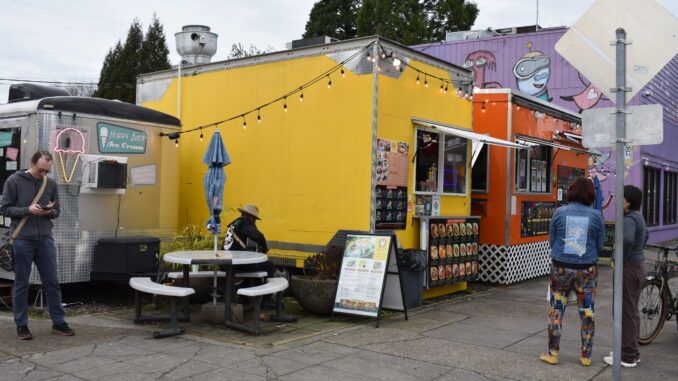
Ever since the COVID-19 pandemic, Portland has struggled to regain its once-vibrant downtown life. In August 2023, a study conducted by the University of Toronto ranked 66 cities across the United States by the extent to which their downtown activity levels have recovered to pre-pandemic levels. Portland was ranked 61.
This study, along with many others, has contributed to Portland’s declining national reputation, as natives and tourists alike report homelessness, open drug use and trash as disincentives to go downtown. The year of 2020 battered Portland’s image, and although it has been described as “a city in decline,” there are many efforts underway to support local businesses and revitalize its economy and culture.
This process’s most recent and visible development was the temporary Portland Winter Ice Rink downtown, near Morrison Bridge. The ice rink opened in mid-December and closed on Jan. 28. It stood along with a “Winter Village” that housed a marketplace, heating lamps, picnic benches, Christmas trees and food carts.
An exciting upcoming project to look forward to is the development of a new skatepark in Old Town, on the west side of the Willamette River near the Steele Bridge. Though this concept began in the early 2000s, the effort has gained traction and financial support in recent years as city planners and community leaders identified urban recreation as a vital ingredient for a fully-recovered downtown. This spring will bring about conversations between Portland Parks and Recreation and project partners regarding feasible designs and property acquisition.
Portland Vibrant Communities Commissioner Dan Ryan, who has served on the City Council since 2020, emphasized the importance of citywide recreation.
“When we have more places to play, there is a better quality of life for our city. Transforming part of Old Town into a citywide recreation destination will be a tremendous asset for our businesses, neighbors, and visitors from all over,” Ryan said in a news release.
Food, in addition to recreation, plays an essential role in a city’s quality of life.
The most recent program aimed at restoring Portland’s vibrancy, and perhaps one of the most alluring ones, has to do with mobilizing food trucks.
Food carts play a vital role in Portland’s economy and culture. They are scattered across the Portland metro area as colorful reminders of the city’s diverse food scene. However, these small businesses face barriers to selling their products downtown. Portland city code 14A.50.040 prevents the sale of merchandise and services on public grounds — specifically, within 250 feet of public park grounds, library grounds or other open businesses selling similar items. Therefore, food truck owners must either pay high prices for licenses on urban properties or seek a spot elsewhere.
This, coupled with the ever-rising taxes in Multnomah County, incentivizes businesses to seek property elsewhere, thus leaving the downtown area and further reducing urban activity.
However, the Portland Bureau of Transportation (PBOT) began a pilot program that seeks to provide more opportunities for local businesses to expand operations onto the street which has been expanded to involve food carts. The goal is to allow greater freedom of movement and additional vendor rights.
On Jan. 17, Portland City Council voted unanimously to waive city code 14A.50.040 for this pilot program through 2025 and, if successful, into 2026. Emergency ordinance 191591 went into effect immediately. The Council’s findings are outlined on portland.gov. Section 1.4 of the Council’s findings describes the essence of the ordinance:
“That PBOT’s pilot program would allow permitted food trucks to vend onto the sidewalk from parking lanes immediately adjacent to the sidewalk, and that written consent of the property owners immediately adjacent to the permit operating area will be required.”
This vote means that food truck owners who are approved through the program will be able to park next to sidewalks downtown — a development that will hopefully attract foot traffic and commercial activity.
The biggest — and only — concern surrounding the change was that urban residents and local businesses might lose valuable parking spaces. However, Right of Way and Permitting Division Manager of PBOT David McEldowny noted in a council meeting that there may only be one food cart per activation.
“So that’s two parking spaces off any one blockface within several blocks of each other. So as far as taking up existing parking, this won’t have a big impact there,” McEldowny said.
This program is aimed at workers returning to downtown Portland who have had limited dining options since the pandemic. City planners are hopeful that, in the coming months, Portland’s food trucks will revive the city’s food scene and thus boost downtown commerce and recreation.
In the next two years, Portlanders can expect to see more mobile food trucks, an increase in the variety of food downtown and greater food accessibility in public parks and spaces. Food trucks will play a key role in bringing people and businesses back into the city.
Although Portland has struggled to recuperate entirely from the pandemic’s toll, it is still very much alive. Local government offices and businesses alike are continually working to revitalize Portland’s city center and restore its tarnished reputation. It is certainly not a city in decline, and has a bright future of restoration and innovation to come.
Subscribe to the Mossy Log Newsletter
Stay up to date with the goings-on at Lewis & Clark! Get the top stories or your favorite section delivered to your inbox whenever we release a new issue.

Leave a Reply